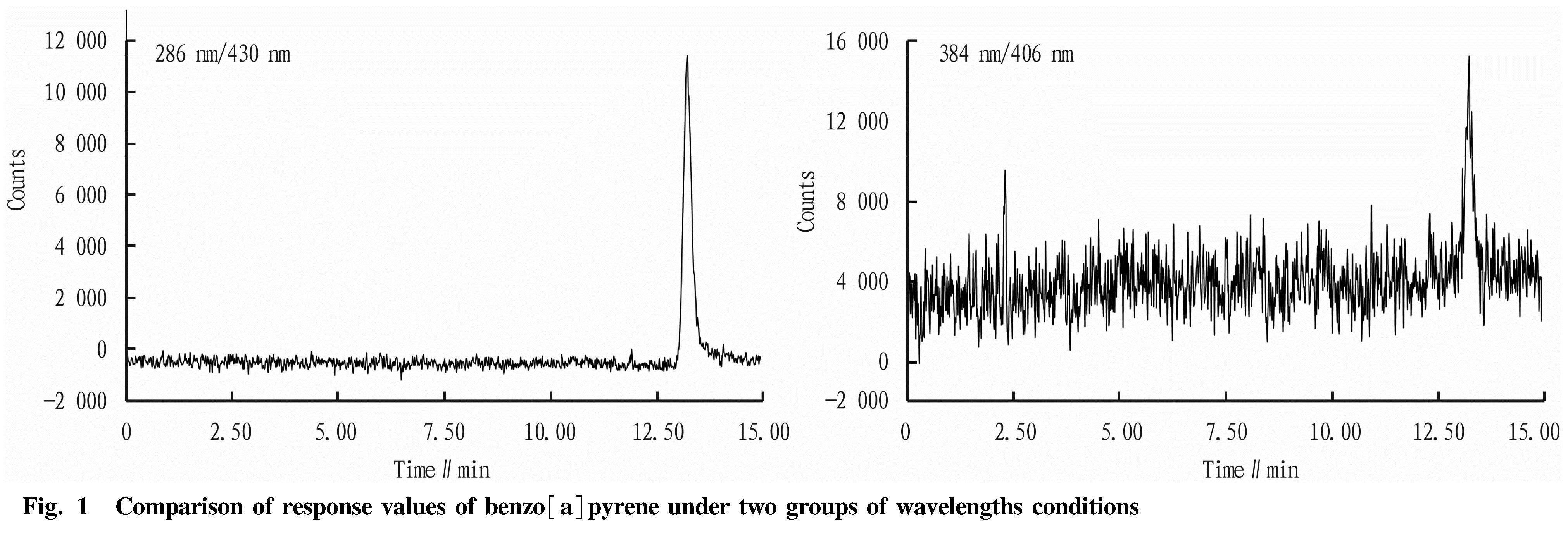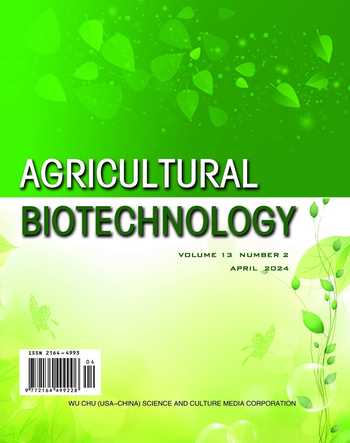Determination of Benzo[a]pyrene in Edible Oil by High Performance Liquid Chromatography-Fluorescence Detector (HPLC-FL)
Guixia YANG Jie LIU Xiujuan WANG Fenglan ZHANG Kun XIN Chunli KONG



Abstract In this study, an optimized high performance liquid chromatography-fluorescence detector (HPLC-FL) method for the determination of benzo[a]pyrene in edible oil was established. HPLC was performed with Thermo Fisher Scientific C18 column (250 mm×4.6 mm, 5 μm) as the chromatographic column and acetonitrile and water as the mobile phase, and the excitation wavelength and emission wavelength of fluorescence detector were 286 and 430 nm, respectively. The response was high, and the linear range was 0.5-10.0 ng/ml. The lowest limit of detection was 0.11 ng/ml, and the average recovery was 92.5%. This method is suitable for quantitative analysis of benzo[a]pyrene content in edible oil.
Key words Benzo [a] pyrene; High performance liquid chromatography; Fluorescence detector
DOI:10.19759/j.cnki.2164-4993.2024.02.003
Benzopyrene is a kind of polycyclic aromatic hydrocarbon[1] formed by the fusion of benzene and pyrene, abbreviated as BaP. According to the different positions of fusion, there can be two isomers of benzo[a]pyrene and benzo[e]pyrene, which are derived from the numbering of chemical bonds in pyrene molecular ring in IUPAC nomenclature. The most common benzopyrene is benzo[a]pyrene. Benzo[a]pyrene is a kind of organic compound with obvious carcinogenic effect. It is a polycyclic aromatic hydrocarbon compound composed of a benzene ring and a pyrene molecule. At present, more than 400 main carcinogens have been detected, more than half of which belong to polycyclic aromatic hydrocarbons. Among them, benzo[a]pyrene is a strong carcinogen. Smoking smoke, high-temperature vegetable oil that has been used many times, burnt food and fried food will all produce benzopyrene[2-5]. GB 2762-2022 stipulates that the limit of benzo[a]pyrene in edible oil is 10 μg/kg. In this study, benzo[a]pyrene[6-8] in edible oil was extracted by solid phase extraction, and the content of benzo[a]pyrene in edible oil was quantitatively determined by high performance liquid chromatography-fluorescence detector (HPLC-FL) under optimized excitation wavelength and emission wavelength.
Materials and Methods
Materials and Instruments
Benzo[a]pyrene standard (Tianjin Alta Scientific Co., Ltd.); edible oil (commercially available); acetonitrile (chromatographically pure); dichloromethane (chromatographically pure); N-hexane (chromatographic purity); experimental water, ultra-pure water; SPE column for MIP-BAP benzo[a]pyrene (Anpel Laboratory Technologies (Shanghai) Inc.); ultrasonic cleaner (Kunshan Ultrasonic Instrument Co., Ltd.); nitrogen Blower (Guangzhou Detelogy Technology Co., Ltd.); electronic balance (Shunyu Hengping); Vanquish Core liquid chromatography-fluorescence detector (Thermo Fisher Scientific).
Experimental methods
Selection of chromatographic conditions
Chromatographic column: Thermo Fisher Scientific C18 column (250 mm×4.6 mm, 5 μm); mobile phase: acetonitrile:water=88:12; injection volume 10 μl; flow rate 1.0 ml/min; fluorescence detector: excitation wavelength 286 nm and emission wavelength 430 nm.
Standard solution preparation
First, 1 ml of benzo[a]pyrene standard (100 g/ml) was accurately transferred, dissolved in acetonitrile, and diluted to constant volume in a 10 ml volumetric flask, and the solution obtained after shaking well was used as a standard reserve solution. Next, the above solution was accurately transferred and diluted with acetonitrile to prepare 0.5, 1.0, 2.5, 5 and 10 ng/ml standard series points.
Sample preparation
First, 1 g of sample was weighed, and added with 12 ml of n-hexane. After vortex-mixing evenly, the solution was loaded to a column for purification. An activated BAP solid-phase extraction column was adopted for the purification, and the purified liquid was collected, and blown dry with nitrogen. Next, 1 ml of acetonitrile was accurately transferred, and after vortex-mixing evenly, and ultrasonic treatment was performed in an ultrasonic cleaner to ensure that the reconstitution solution was completely dissolved. Finally, the reconstitution solution was filtered with a microfiltration membrane for testing.
Results and Analysis
Selection of excitation wavelength and emission wavelength of fluorescence detector
In this study, two groups of excitation wavelengths and emission wavelengths were selected as the fluorescence detection conditions for comparison, and the standard point response value at the same concentration of benzo[a]pyrene (1.0 ng/ml) was taken as the index. The results showed that the response of benzo[a]pyrene with excitation wavelength of 286 nm and emission wavelength of 430 nm was obviously better than that with excitation wavelength of 384 nm and emission wavelength of 406 nm, as shown in Fig. 1. The detection limit, linear relationship, precision, repeatability and recovery were investigated at the selected wavelength.
Determination of detection limit
With three times of the signal-to-noise ratio (S/N) as the standard, the corresponding concentration was the detection limit. Accordingly, the detection limit was 0.11 ng/ml.
Investigation of linear relationship
A standard curve with peak area as the ordinate and concentration as the abscissa was drawn, as shown in Fig. 2. The regression equation was obtained as y=3 853.7x-877.69, R2=0.999 6, and the linear relationship was good in the range of 0.5-10.0 ng/ml.
Precision test
The standard solution (10 ng/ml) was selected for six times of repeated injection, and the peak areas of chromatograms were recorded (37 031; 37 265; 38 014; 37 047; 37 383; 37 472). The average value (37 369) and relative standard deviation were calculated (1.0%). The relative standard deviation of this precision test was 1.0%, indicating that the precision of benzopyrene determination was good.
Reproducibility test
For the same edible oil sample, the extraction and determination were repeated for six times. The determination results were 0.589, 0.564, 0.576, 0.556, 0.576, and 0.566, with an average value of 0.571 μg/kg, and the relative standard deviation was 2.0%, indicating that this method had good reproducibility in determining the content of benzopyrene in edible oil.
Recovery test
The sample was accurately weighed for six times, and benzopyrene was accurately added at an amount of 0.5 μg/kg. The solution to be detected was obtained according to the above sample extraction process, and quantified by the external standard method. The results are shown in Table 1.
Table 1 shows that the recovery values of this test were in the range of 88.2%-99.4%, and the average recovery was 92.5%. It indicated that this method had good accuracy in detecting benzopyrene content in edible oil.
Conclusions
In this study, the detection limit, linear relationship, precision, reproducibility and recovery were investigated under the optimized wavelength conditions, and the results were good. It shows that this method is suitable for the determination of benzopyrene in edible oil.
References
[1] SHI QQ, XI J, LU QY. Research progress of benzopyrene in food[J]. Science and Technology of Food Industry, 2014, 35(5): 379-381. (in Chinese).
[2] ZHENG Y, JIN CJ, HE JG. Effect of different oils on benzo(a)pyrene content in fried foods [J]. Food Science, 2020, 41(16): 94-100. (in Chinese).
[3] FENG YJ, WANG RX, LI SG. Review on the sources and reducing strategiesof benzo(a)pyrene in foods[J]. Cereals & Oils, 2017, 30(2): 72-75. (in Chinese).
[4] QUAN MP, WU MY. Hazardness and control measures of benzo(a)pyrene in smoked and roasted meat products[J]. Biotic Resources, 2012, 34(3): 66-68. (in Chinese).
[5] WU D. The harm and prevention measures of benzopyrene pollution in food[J]. Science and Technology of Food Industry, 2008, 29(5): 309-311. (in Chinese).
[6] ZHENG XP, DING LP, CHEN ZT, et al. Determination of benzo[a]pyrene in vegetables by HPLC[J]. Physical Testing and Chemical Analysis Part B: Chemical Analysis, 2015, 51(10): 1437-1439. (in Chinese).
[7] WU M, LI Z, LI CY, et al. Determination of benzopyrene in food by solid phase extraction-high performance liquid chromatography with fluorescent detector[J]. Journal of Food Safety and Quality, 2012, 3(2): 82-88. (in Chinese).
[8] LU JY, TANG ZF. Determination of benzopyrene in food by high performance liquid chromatography[J]. Modern Food, 2017(1): 116-117. (in Chinese).
- 农业生物技术(英文版)的其它文章
- Research Progress on Effects of Continuous Cropping on Soil Microbial Florae and Its Restoration
- Slaughter Performance, Muscle Quality and Nutritional Composition of Duoluo Goats in Sichuan Province
- Analyses of Chicken Tenderness Traits Based on Transcriptome Sequencing
- Effects of Different Grinding Methods on the Quality of Soybean Bean Milk
- A method for Improving the Efficiency of Pear Tree Crossbreeding
- Analysis of the Effect and Influencing Factors of Rural Domestic Sewage Treatment Based on A2O-MBBR Integrated Process

